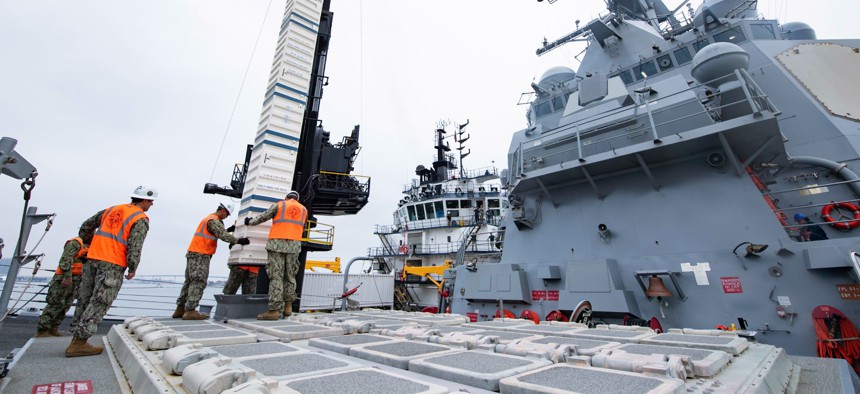
Sailors aboard the destroyer Spruance load a training missile from MV Ocean Valor into a VLS cell during a proof-of-concept evolution in San Diego, Oct. 4, 2022. U.S. Navy / Mass Communication Specialist 3rd Class Taylor Crenshaw
US Warships Need Faster Ways to Rearm, Repair, Navy Secretary Says
Carlos Del Toro has also ordered up several steps intended to improve his service’s tech innovation.
The Navy needs to work out how to repair and rearm warships faster to get them back into a fight, the service’s secretary said Thursday.
“Being able to quickly rearm our warships’ vertical launch tubes at sea will significantly increase forward persistent combat power with the current force. No longer will our combatants need to withdraw from combat for extended periods of time to return for vulnerable in-port reloading of weapons systems,” Carlos Del Toro said during a speech at Columbia University in New York City.
Reloading VLS tubes—the Navy’s current destroyers carry nearly 100 apiece—has long required a ship to come dockside so a crane can lift and dangle replacement missiles down into the launcher cells. But the service has been working on ways to do it at sea since at least 2016. An October test aboard the destroyer Spruance in San Diego harbor marks, in Del Toro’s words, an “early step in the right direction and paves the way for expedited development.”
“My intention is to perfect this capability and field it for sustained, persistent forward strike capacity during wartime,” he said.
Del Toro also wants to figure out faster ways to get combat-damaged warships back in the fray. Repairs to heavily damaged vessels—for example, the frigate Stark, the destroyers Cole and Fitzgerald—have typically taken more than a year. Faster work will require upgrading and even expanding shipyard capability, he said, including what’s already being done in Navy’s Shipyard Infrastructure Optimization Program, or SIOP.
“We know that in a high-end naval conflict with a peer competitor, we will need to repair and even revive ships at tremendous speed. And we will need to do so as close to the fight as possible so that even damaged ships can return to battle quickly,” he said. “The intense repair and revive demands of a high-end conflict in Asia will require significant shipyard capacity in the United States and also in the Pacific. Accordingly, we are testing our wartime assumptions and looking for opportunities to expand our public shipyard capacity at home and abroad.”
Chief of Naval Operations Adm. Mike Gilday has made reducing delays and improving planning for heavy maintenance projects—”availabilities” in Navy-speak—a top priority in his 2021 Navigation Plan.
Another area that Del Toro wants to focus on is innovation across the service.
“The best way to deter adversaries is for the department to restore its technological superiority,” he said.
A Navy Department science and technology advisory board will be created with leaders and experts to give “independent recommendations on our science and technology portfolio,” he said.
Del Toro has also ordered the establishment of a “Navy innovation center” at the Naval Postgraduate School in California.
“That will serve as a premier military education facility tailored to innovation and experimentation serving as a technology resource for Navy and Marine Corps warfighting development commands, as well as a go to partner of the defense industrial base, the technology sector, and academia, like here at Columbia,” he said.




